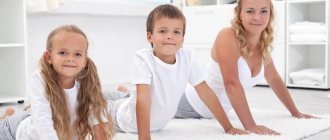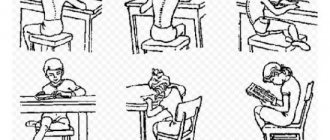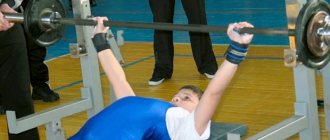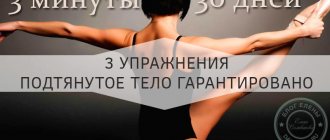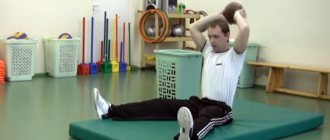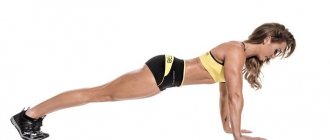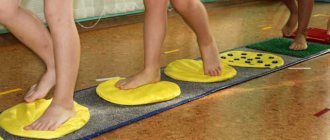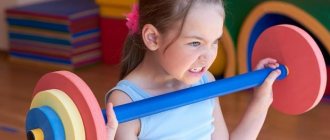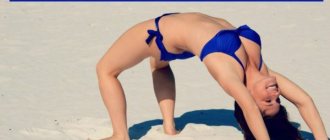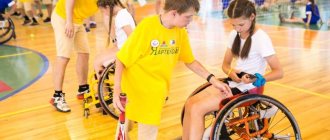Most people think that aerobics is a sport for women aimed at losing weight. A picture of group exercises in the gym or energetic movements at home in front of the TV appears before your eyes.
But this is far from true. This sport can be practiced by everyone, including children. This is very beneficial for the health and harmonious development of the child. In essence, children's classes are similar to adult fitness, only in a simplified and abbreviated form.
The exercises are diluted with dancing to cheerful music, as well as game elements. This sport is suitable for children of any age.
There are no special restrictions for classes. Even if you have any chronic diseases, such as asthma or other pulmonary diseases, you can choose a special program with a light load.
Contraindications can only be injuries, serious diseases of the heart, respiratory system, spine, etc.
Dance aerobics
For those who want to develop a child’s musicality, hearing, sense of rhythm and plasticity, as well as strengthen the muscles of the body as a whole, dance aerobics for children is suitable.
In addition, it improves memory and attentiveness, since it is necessary to remember dance movements.
Typically, a lesson is divided into three parts: warm-up, main part and cool-down.
Features of children's aerobics
Aerobics is considered the most authentic and challenging sport . Judge for yourself. It simultaneously includes gymnastic exercises, various artistic elements, dance movements and elements used during fitness classes. Aerobics can be done both at home and by visiting a special section. All sports and dance movements should be performed to music.
Whole varieties of children's aerobics are known. Let's get to know them better.
Sports aerobics
This is a more difficult type of aerobics. It is better to bring children five to six years old to such classes.
Sports aerobics for children includes many elements from gymnastics, but without acrobatics.
Trains strength and endurance. Develops the vestibular apparatus, the ability to control one’s body, and forms a strong muscle corset.
What to do with
Being active means being healthy. It is not necessary to engage in fitness professionally and achieve high results. To stay in shape, simply exercise regularly and expose yourself to moderate physical activity. Aerobics and fitness are disciplines that are aimed at keeping fit. But in addition to exercise, they require adherence to a daily routine, healthy eating, and proper rest.
For the classes to be truly beneficial, your child will need the right equipment. It includes many products such as fitball, jump rope, mat, hoop. Having which the child will be able to fully train at home.
From the age of 8, work with sports equipment begins: a ball, a jump rope, a hoop. Various team games can be arranged for children.
Fitness ball
A fitball is a special large rubber fitness ball that has many advantages:
- lightweight - can easily be rolled or moved to another place;
- durable – can withstand weight up to 180 kg;
- does not explode, thanks to a special anti-explosion system;
- multifunctional – allows you to perform various exercises;
- develops coordination of movements;
- has no age restrictions - suitable for infants, pensioners, children and adults;
Fitness balls come in different sizes depending on the height and weight of the child. To understand whether the fitball is chosen correctly you need to:
- sit on the ball;
- position your legs so that your feet fit snugly to the floor;
- make sure that your knees are bent at right angles;
If all points match, then the size is chosen correctly.
You can also choose the color of the ball, its surface (smooth or textured). In addition, fitballs come with or without handles.
Rug
A gymnastic mat is an indispensable item for aerobics and fitness classes for your children. Of course, sports clubs can offer their mats for temporary use, but it is better to have your own. After all, you can work with it anywhere.
To choose the right rug size, simply add 10 cm to the child’s height. The width and thickness of the rug also vary. You need to choose them based on your feeling of comfort.
Important! The thinner the thickness, the colder and harder it will lie on the mat.
Today, training mats are available in a wide variety of bright colors. Your child will be happy to take such convenient, practical and lightweight equipment to class.
Step
A step platform is a specially designed platform for fitness and step aerobics that simulates climbing and descending stairs.
Due to the fast pace of life, there is not always time to go to the gym, so the option of home workouts remains. Sports equipment is ideal for this purpose. One of them is a step platform, which is very practical and effective.
Now it is used in step aerobics, for cardio training and as an auxiliary equipment for performing various exercises.
Externally, the step platform resembles a rectangular bench with adjustable height. When choosing a step platform, pay attention to the following:
- material – the working surface should not slip;
- platform dimensions - depends on the size of the foot;
- height adjustment;
- stability – step platforms must be equipped with rubber “feet” to prevent slipping on the floor;
The step platform is used in classes with children such as:
- morning exercises;
- aerobics (10-15 minutes of platform exercises);
- during training preparation for sports holidays;
- during training for children of senior preschool age (25-30 minutes of training on a step platform).
All of the above activities will lead to overall strengthening of the body and normalization of metabolic processes.
Jump rope and hoop
Another sports attribute is a jump rope. Thanks to the jump rope, you can train different muscle groups at the same time. In addition, the jump rope also allows you to develop coordination of movements, endurance, train the cardiovascular system and significantly increase lung capacity.
A jump rope is a simple but very effective sports equipment for training, both in the gym and at home.
Step aerobics aerobics
As in adult classes, this type of exercise uses a step platform, but it is smaller in size - about 10 centimeters in height. Includes a set of various steps and jumps.
Teaches you to be agile, fast and attentive, and to keep your balance well. Trains the cardiovascular system.
Tips for beginners
Before starting training, we recommend considering the following factors:
- A standard set of aerobics exercises strengthens the overall tone of the body and burns excess calories without focusing on certain areas. If you want to focus on a specific problem area, then you need to select the appropriate set of aerobic exercises;
- Before each workout, a warm-up is required. Warming up will help avoid injuries and muscle strains;
- Before you start exercising, make a clear training plan. Any sport loves a clear and thoughtful approach.
Babies 1-1.5 years old
You can start training as early as a year and a half. Even for such little ones, this is very useful, since physical development is closely related to intellectual development.
Of course, for such kids the exercises will be the simplest and take little time. About ten minutes is enough for children.
Often such fitness breaks are included in the program of general developmental activities for children in order to change the type of activity and not overstay their welcome.
The lesson is always held in a playful way, using various paraphernalia, such as balls, rings, fabric tunnels, orthopedic mats, various toys, etc.
The movements are simple - running, squats, various steps, crawling. These workouts allow you to get active and have fun.
Children 3-5 years old
For older children, classes become more difficult. They are also built in the form of a game, since at this age children are very active and energetic.
The game form is aimed at making it interesting, but at the same time performs the function of physical development.
In addition, it helps to slightly restrain the activity of the kids and spend their energy usefully. The child learns to control himself and focus his attention.
Exercises for children's aerobics of this age consist of squats, jumps, elements lying on the floor, and dance movements.
A variety of equipment is also used - hoops, benches, ladders, cubes and balls, special sticks, and so on.
The muscles are actively involved in work, flexibility and coordination develop, and flat feet are prevented.
The duration of such lessons is about 20-30 minutes, no more, twice a week.
Main types
There are several varieties.
Dance
Involves performing a number of movements in a dance format. All movements used can relate to different types of dances. This aerobic activity should last no more than one hour a day. The loads are moderate.
Each lesson consists of three parts:
- A short warm-up, lasting 10 minutes.
- The next part is considered the main one. Its duration is 40 minutes. During this time, children perform various exercises, as well as dance movements. All choreographic elements are performed to the accompaniment of exciting children's songs.
- The final part of dance aerobics is stretching and relaxation. Like the warm-up, these actions are performed within 10 minutes. Stretching and relaxation allow the body to recover and recover from stress.
Children of school age (7−13 years) and older can engage in dance aerobics. Thanks to such activities, children increase their level of endurance and also improve coordination of movements. Dance aerobics helps to accustom a child to a full and healthy lifestyle.
Animal aerobics . This type with an interesting name involves performing exercises that resemble the movements of animals.
Sports
This species is fundamentally different from all other varieties. It is considered a real sports direction, which in the future may become part of the Olympic Games program.
Preschoolers 5-6 years old
Aerobics for preschool children is close to adult programs. The exercises become more complex and more varied.
During training, inclined planes, mats, jump ropes, and fitballs are used. Complex tasks are added, such as somersaults and relay races. Increasing cardio loads.
The duration of aerobics classes for children 5-6 years old is 30-40 minutes 2-3 times a week. They can be diluted with dance elements, but the emphasis is on strengthening muscles and developing physical capabilities.
There are also exercises that develop logic. Children learn to work in a team and interact with each other.
However, the elements of the game remain. This allows you to maintain interest and desire to come to training again.
Features and basic rules of aerobics for children
Special halls are equipped for classes, and children's rooms are set up. It is desirable to have:
- Swedish wall or children's sports complex;
- a dry pool filled with balls;
- rope, swings, soft modules, etc.
Children's club "World Class"
The basis of children's aerobics is basic aerobic steps, which are specially adapted for children. The exercise sets are designed in such a way that they take into account the age of the students, their development, characteristics, and interests.
Duration of classes
Experts say that children can perform exercises to music from the age of 1...1.5 years. The duration of classes varies for different age groups. Until the age of two, it is a maximum of 8...10 minutes, then it can be increased to 20 minutes. (up to 3 years). There are special techniques that make it possible for a child under 3 years of age and his mother to study together.
Schoolchildren 7-11 years old
At this age, children's physical activity decreases because they have to sit in class at school and then do homework while sitting at the table. School physical education lessons are not enough to keep muscles toned and maintain the same metabolism.
These circumstances can even lead to obesity, which negatively affects children's health. At the same time, the body’s need for movement only increases. Children's aerobics would be a great solution.
The training program for primary school age includes quite complex elements - gymnastics, dance, strength.
Balance exercises, various jumps, rotations, and hangs are included. It is possible to use special children's simulators. A trainer must teach you how to use them.
The workout takes on average 40-45 minutes. It should not be monotonous; exercises should be selected at different intensity.
Speed, agility, strength, flexibility develop and all muscles of the body are strengthened.
At 7-11 years old, physical qualities can develop to their maximum, since the nervous system is already quite mature by this age.
Children are emotional and react quickly, which allows them to learn new skills better, more accurately and in a fairly short time.
You can take part in competitions, and victories and prizes give you confidence in your abilities.
CONTENT OF CHILDREN'S GYMNASTICS
Lesson content: Part 1 of the lesson (15 min) consists of a fun dance aerobic warm-up. Part 2 of the lesson (20 min) consists of 7 easy-to-perform strength exercises in a lying position that will help form an active muscle corset for your child’s spine from living muscles.
CHILDREN'S SCOLIOSIS AND KYPHOSIS IS A GLOBAL PROBLEM!
Dear parents, Aerobic training + 7 exercises for the spine - this therapeutic and preventive set of exercises should be in every family of a first-grader! Because the age of general computerization and physical inactivity has made the problem of scoliosis and kyphosis in schoolchildren , then early juvenile osteochondrosis and even intervertebral hernias.
Computers and voluminous school programs force children to spend a lot of time in a sitting position, in which the child’s spine experiences a long-term, static, destructive, vertical load. Unfortunately, 2 school physical education lessons do not solve important problems: sufficient physical development of schoolchildren and the formation of a protective muscular corset for their spine.
The proposed set of exercises is aimed at solving this most pressing problem today, which is regular and targeted training.
The complex contains the most accessible and simple to perform, but technically correct exercises directly aimed at the formation of a muscle corset, which should consist of equally developed muscles of the front surface, back surface and lateral surfaces of the child’s torso.
Only strong muscles are protective walls for the passive bone structure of the spine; they will take on the vertical load, stabilize the child’s spine, straighten the curvature of the bone structure of the spine, and will reliably protect and support it. Preserving the health of the spine of their own children, timely care and strengthening of the muscle corset is the direct responsibility of parents! Advanced scoliosis of 3-4 degrees and the presence of a hump in a child, and suffering from back pain in the future is the fault of parents who are inactive or shift their responsibilities to teachers and doctors.
Remember! That curvature of the spine can be prevented, and that curvature can be straightened by taking timely measures, namely, by doing technically correct exercises.
GOALS AND OBJECTIVES OF CHILDREN'S GYMNASTICS
The 1st part of the lesson (15 min) is an aerobic workout accompanied by cheerful music, it will invigorate the child well, and a professionally balanced load will increase the functionality of the cardiovascular system, increase the volume and ventilate the lungs, and activate metabolic processes in the body;
2nd part of the lesson (20 min): consists of 7 strength exercises while lying down - this is the minimum exercise required to form a muscle corset and strengthen the abdominal muscles, back muscles and buttocks, and lateral muscles of the torso; The complex ends with exercises for flexibility and mobility of the joints of the spine.
The complex will solve important problems:
- will correct posture and strengthen the muscle corset before starting school;
- will strengthen the muscle corset and correct existing grade 1 scoliosis;
- will stop the progression of existing scoliosis and kyphosis;
- corrects stoop;
- will educate and instill in the child responsibility for maintaining the health of his own spine;
- will ensure replenishment of the necessary motor volume;
- will provide a complete workout and activate the work of all body systems;
Daily muscle training should be as necessary a hygiene procedure for your child as brushing your teeth! From an early age, instill in your children a culture of health and a love of movement, and then your children will grow up healthy and with beautiful, even posture.
A live lesson with children is a practical guide for future physical education teachers.
For the harmonious physical development of your child, I recommend alternating the complex for the spine with the complex Development of Agility, Strength, Speed and Coordination.
GENERAL INFORMATION
The proposed complex was produced for children 4-11 years old and should be in every family of a future first-grader and primary school student
The age of general computerization and physical inactivity has made the problem of scoliosis and kyphosis in schoolchildren GLOBAL; later, these diseases will become the cause of early osteochondrosis and intervertebral hernias in the adult population. I want to reach out to parents and let them know that:
Computers and complex school programs force children to lead a sedentary lifestyle; 2 school physical education lessons do not fill the necessary motor mode and do not solve the problems of harmonious physical development of children, and even more so, do not ensure the formation of a muscular corset for the spine. To my great regret, coaches in sports sections are results-oriented in any way, and do not notice how scoliosis develops in their players. And believe me, the doctor who has determined the curvature of the spine will not stay up all night and solve the problem of how to cure your child. He will forget about your existence as soon as you close the door of his office behind you; at best, he will prescribe a massage and swimming, which will not solve your problem. Some doctors who have been caring for your child and prescribing various procedures for several years will eventually offer to operate, i.e. insert a metal structure when the child’s rapid teenage growth stops. In most cases, spinal surgery has no effect.
Therefore, in the current situation, timely care and strengthening of the spine, namely, maintaining the health of the spine of their own children, is the direct responsibility of parents!
Parents, be careful! The proposed complex was released to help parents.
Teenagers 12-16 years old
The guys have completely matured, they are actively growing, but their muscles cannot keep up with the growth rate. In addition, at this age puberty occurs, all systems in the body begin to work in a new way. Aerobics will help you develop physically and look harmonious.
Now children can control the excitability of the nervous system and concentrate better. During training, the emphasis is on strength, endurance and flexibility, strengthening the muscle corset.
Complex gymnastic elements are added, including acrobatic ones. Work is practiced both independently and in pairs or teams.
It is possible to use adult simulators, but only without axial load. The spine is still immature in a growing body, so exercises like squats and deadlifts are dangerous.
Training should not take more than one hour, 2-3 times a week. They must include a warm-up at the beginning and stretching at the end, as well as cardio training.
Benefits of Aerobics
Aerobics exercises heal the entire body, and among the main benefits are the following:
- As a result of regular exercise, metabolism normalizes. The body begins to reproduce calcium, due to which the skeletal system is strengthened;
- The functioning of the cardiac and circulatory systems improves. This is due to rhythmic movements accompanied by uniform breathing, which significantly strengthens the heart muscle and also destroys cholesterol plaques;
- Regular exercise will help relieve muscle tension and also relieve stress. Improves well-being and mood;
- Helps improve lung function;
- Aerobics is one of the most accessible and easiest ways to work out all muscle groups. thanks to exercise, the body gains endurance and strength;
- Aerobics is a great way to burn extra pounds. Thanks to training, you will very quickly gain a beautiful and elastic body.
A little about the musical accompaniment
Music during training is not just background. It sets the pace, rhythm, invigorates, gives strength and adds a good mood. Therefore, music for children's aerobics plays an important role in the structure of the lesson.
The music is selected by the trainer, based on the age of the group and the type of aerobics. First of all, you need to choose a tempo. The speed of execution of elements depends on this:
- Dance aerobics involves upbeat, cheerful music to which you can dance happily;
- For sports, calmer music is suitable, allowing you to concentrate on doing the exercises;
- It is better to choose musical accompaniment for step aerobics with a clear rhythm and a fairly high tempo.
For small children, the playlist is made up of children's songs, including familiar melodies from cartoons.
There are also special songs with movements for kids, when you need to listen to what is being sung and repeat.
The main thing is that children enjoy music and classes in general and go to the gym with joy.
Who is aerobics for?
This set of exercises is most often chosen specifically to combat extra pounds. In a short time you can achieve very tangible results.
It is important to consult your doctor before starting exercise. So classes are contraindicated:
- For chronic diseases,
- For heart diseases,
- With an increased body mass index.
No special knowledge is required to start training. Ideal for those who do not have a lot of time to spend. It does not require visiting the gym; you can study at home using video lessons.
Benefit
The benefits of aerobics are difficult to overestimate. It has a positive effect on various aspects of a child’s development:
- First of all, it improves physical development - strong muscles, strength and flexibility, a beautiful figure, even posture, absence of flat feet, a healthy back and the musculoskeletal system in general;
- Trains the ability to control your body well, coordination and endurance;
- Helps to spend energy, which children have a lot of, directing it to useful things. Thanks to this, children become more diligent and attentive, sleep well and soundly;
- Heals all body systems - respiratory, cardiovascular, improves metabolism. Eliminates the possible problem of obesity (mainly in schoolchildren who move little, sitting in class, doing homework and spending time on computers and gadgets);
- Strengthens immunity
Medical contraindications
Aerobics has virtually no contraindications. You can choose any combination of exercises in accordance with the child’s health condition and enroll in a specialized group. For example, high-impact exercises will be contraindicated for children with respiratory diseases, but swimming or yoga will be beneficial. General contraindications include only serious diseases of the heart, respiratory system, trauma, disorders of the musculoskeletal system, exacerbation of chronic, viral or infectious diseases.
